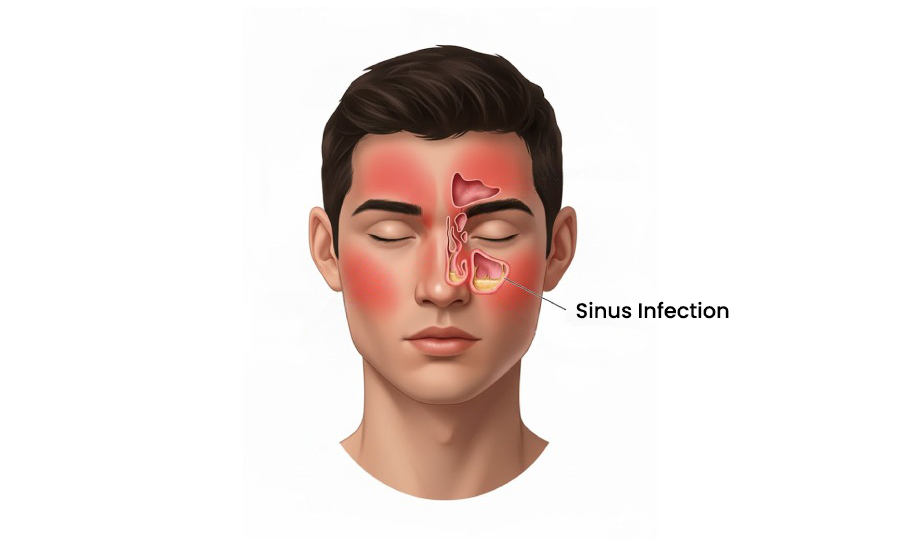Stuffy nose, sore throat, heavy feeling in your head—you assume it’s just a cold. But as the days pass and the symptoms don’t improve or become worse, you might wonder if it’s a cold or a sinus infection?
Both cold and sinus infection have similar symptoms, so it can often be difficult to tell them apart. However, there are a few key differences—especially when it comes to the duration of symptoms.
Let’s take a closer look at sinus infection vs cold. Learn the key differences between both conditions and how they can be treated.
What is Common Cold?
Common cold is one of the most common illnesses people experience, especially in the colder months. It’s caused by viruses (most commonly by rhinoviruses) that infect your upper respiratory tract—your nose, throat, and sinuses.
Although it’s uncomfortable, it usually clears up on its own.

Common Symptoms of a Cold
Cold symptoms usually develop gradually and last around 5 to 10 days.
Typical cold symptoms include:
- Runny or stuffy nose
- Sneezing
- Sore throat
- Mild cough
- Slight body aches
- Hoarseness of voice
- Feeling tired and generally unwell
What is Sinus Infection?
Sinus infection or “sinusitis” occurs when the tissues lining your sinuses—air filled spaces behind your forehead, cheeks, and nose, become inflamed or swollen.
This causes blockage of normal mucus drainage from sinuses, leading to build-up that can cause infection.
Sinus infection can be viral, bacterial, or even triggered by allergies.

Common Symptoms of a Sinus Infection
- Pain or pressure around forehead, cheeks, and nose
- Thick yellow or green nasal discharge
- Blocked or stuffy nose
- Headache
- Cough
- Bad breath
- Fatigue or feeling generally unwell
- Pain in your upper teeth or jaw
- Feeling of pressure in ears
How to Tell if You Have a Cold or a Sinus Infection?
The main difference that can help you distinguish between a cold and sinus infection is how long it lasts. Usually a cold gets better within 5 to 10 days, while sinusitis symptoms can last up to 4 weeks or even several months, if it becomes chronic.
If your “cold” symptoms seem to get worse after improving, or last longer than 10 days without getting better, it’s likely a sinus infection.
Sinus Infection vs Cold | Key Differences at a Glance
| Common Cold | Sinus Infection | |
| Cause | Virus | Virus, bacteria, or allergies |
| Duration | Usually 5—10 days | 10 days or longer |
| Nasal discharge | Clear or slightly cloudy | Thick yellow or green |
| Facial pain or pressure | None or mild | Common and often severe |
| Fever | Low fever | Higher fever, especially in bacterial infection |
Can a Cold Turn into a Sinus Infection?
Sometimes a cold can actually lead to a sinus infection. The virus that causes cold can make your nasal passage swell, trapping mucus in your sinuses. When this trapped mucus gets infected with bacteria, it causes bacterial sinusitis.
Doctors often look for a “double worsening” pattern—when symptoms that apparently looked like a cold start to improve after some days but then suddenly start getting worse. This is a sign that a bacterial infection may have developed.
Treatment Options for a Cold and Sinus Infection
For a Cold
There’s no cure for common cold, but you can manage your symptoms by:
- Plenty of rest and fluids—staying hydrated helps thin mucus and prevent dehydration
- Steam inhalation or nasal sprays—to help keep nasal passages clear
- Pain relievers like paracetamol and ibuprofen for headaches, body aches, and sore throat
- Honey and warm drinks for cough and throat irritation. (Here’re some more home remedies for chronic cough that you can try)
Avoid taking antibiotics—they won’t help with viral infection and can contribute to antibiotic resistance.
For Sinus Infection
A sinus infection usually lasts longer than a cold, but it can still get better on its own.
To relieve symptoms you can use:
- Rest and plenty of fluids
- Steam inhalation
- Nasal saline rinses
- Warm compresses over your face to reduce pressure
- Over-the-counter decongestants or nasal sprays—they can provide short-term relief but avoid using them for more than few days in a row
- Pain relievers like paracetamol and ibuprofen for headaches and facial pain
- Honey and warm drinks for cough and throat irritation
If your symptoms persist for more than 10—14 days, become severe, or include high fever or swelling around your eyes, you should see your doctor.
If bacterial infection is confirmed, your doctor might prescribe antibiotics.
People with chronic sinusitis (symptoms lasting longer than 12 weeks) might need further evaluation from an ENT specialist. In some cases, surgery may be performed to improve sinus drainage.
Final Thoughts
It’s easy to confuse a lingering cold with a sinus infection, as they both have some similar symptoms.
The key difference lies between the duration and intensity of your symptoms.
A cold tends to come and go within a week while sinusitis lingers causing facial pressure, thick mucus, and bad breath.
If your symptoms persist or get worse, check in with your doctor for a proper diagnosis and management.








